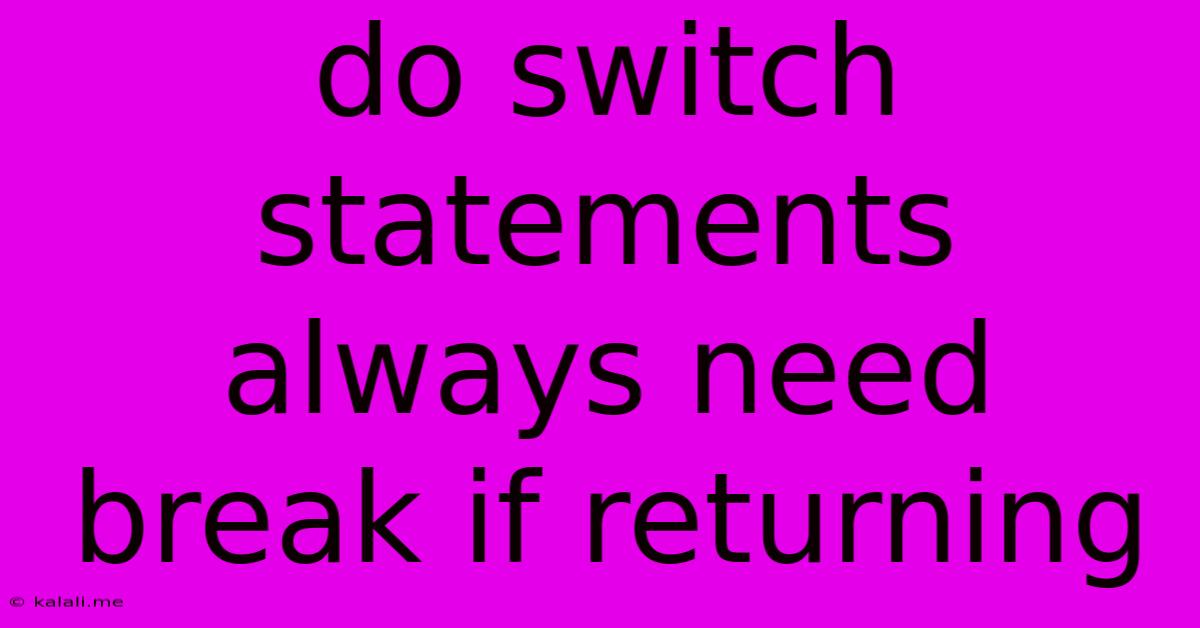Do Switch Statements Always Need Break If Returning
Kalali
May 31, 2025 · 3 min read

Table of Contents
Do Switch Statements Always Need break if Returning?
The short answer is: no, break statements are not always necessary in switch statements if you're returning from a case. However, understanding why this is true requires a deeper dive into how switch statements function and best practices for clean, maintainable code.
This article will explore the behavior of switch statements in various programming languages, specifically focusing on the interaction between return statements and break statements within cases. We'll examine scenarios where omitting break is acceptable and others where it's crucial for correct functionality. The goal is to provide a clear understanding of when to use and when to omit break statements within your switch statements for optimal code efficiency and readability.
How Switch Statements Work
A switch statement provides a structured way to select one block of code to execute from multiple candidates based on the value of an expression. The fundamental structure involves a switch expression and multiple case labels, each representing a possible value. When the switch expression matches a case label, the associated code block is executed.
The key difference in behavior lies in how the flow of control continues after a case is executed. Without a break statement, execution will fall through to the next case, executing the code in subsequent cases until a break is encountered or the end of the switch statement is reached.
return vs. break within Switch Cases
The crucial point is that a return statement immediately exits the function (or method) in which it's called. This implicitly halts execution of the switch statement. Therefore, when a return statement is present within a case, a break statement is often redundant. The return statement effectively prevents "fallthrough" behavior.
Example (C++, Java, JavaScript, and similar languages):
public int getDayOfWeek(int dayNumber) {
switch (dayNumber) {
case 1:
return 1; // No break needed; return exits the function
case 2:
return 2; // No break needed
case 3:
return 3; // No break needed
default:
return 0;
}
}
In this example, each case returns a value. The return statement terminates the function execution, making the break statements unnecessary. Adding them would be stylistically redundant but wouldn't cause an error.
When break is Still Necessary (Even with return)
While less common with the use of return, there are situations where a break might still be beneficial, even if a return is present. These are primarily scenarios dealing with error handling or specific logging/debugging within a case.
Example (Illustrative, language-agnostic):
public int processData(int data) {
switch (data) {
case 1:
// some processing
if (someErrorCondition) {
logError("Error occurred in case 1");
return -1; // Return with error code
}
return 1; // Normal processing
case 2:
return 2;
default:
return 0;
}
}
Here, although we use a return within the if block to handle the error, a break statement after the return might improve code readability and clarity, especially in more complex scenarios. It clearly separates the error handling path from the normal processing path within case 1.
Best Practices
- Consistency: Choose a style (use
breakor omit it consistently) and stick with it throughout your project for maintainability. - Readability: Prioritize code clarity. If omitting
breakimproves readability in simple cases, do it. However, in more complex situations, explicitbreakstatements can enhance understanding. - Explicitness: While
returnoften makesbreakredundant, explicitly includingbreakenhances code clarity and reduces potential ambiguity. It removes the need to carefully consider fallthrough behavior.
In summary, while break statements aren't strictly mandatory within switch cases that use return statements, prioritize code clarity and consistency. Choose the style that best suits your project's coding standards and makes the code easiest to understand and maintain. The importance lies not in strictly adhering to a rule, but in writing clear and easily maintainable code.
Latest Posts
Latest Posts
-
What Does The Bagel Button Do On A Toaster
Jun 01, 2025
-
Lightgbm Warning No Further Splits With Positive Gain Best Gain
Jun 01, 2025
-
Why Didnt Moses Enter The Promised Land
Jun 01, 2025
-
How Heavy Is A Barbell Without Weights
Jun 01, 2025
-
Add Subject Alternative Name To Ssl Certificate
Jun 01, 2025
Related Post
Thank you for visiting our website which covers about Do Switch Statements Always Need Break If Returning . We hope the information provided has been useful to you. Feel free to contact us if you have any questions or need further assistance. See you next time and don't miss to bookmark.